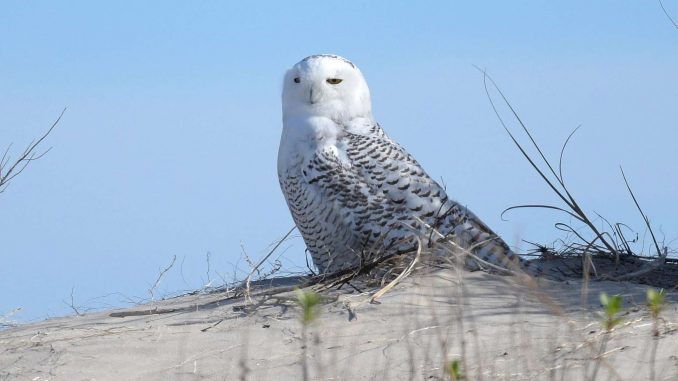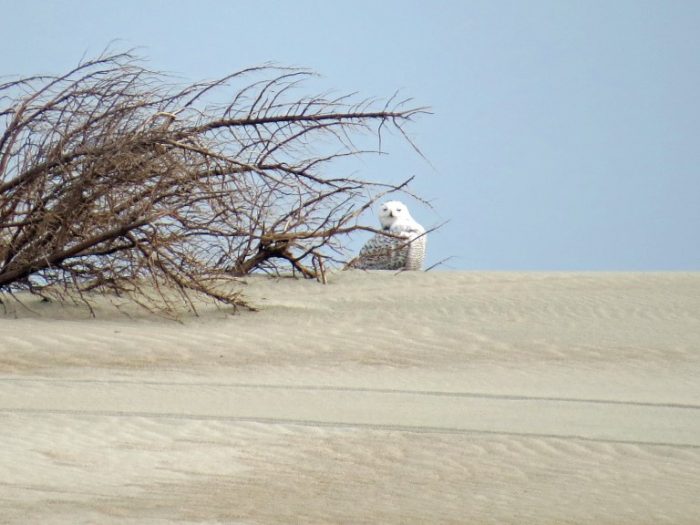
Note: If you search for this owl, keep a distance so as not to spook it causing it to fly away. These photos were taken with a long lens.
Ocracoke went on alert to the possibility that a Snowy Owl would return here when one was seen Dec. 29 on Pea Island.
According to OBX Today, the bird was seen and photographed the next day a few miles away by Brian Patterson. Subsequent off-and-on sightings continued. The Island Free Press reported one on Jan. 7 perched on a house in Hatteras village, increasing the expectations that it would show up on Ocracoke.
Several searches on Ocracoke failed to find one until yesterday.
“My daughter, Elizabeth, and her boyfriend, Walker Garrish, saw it yesterday,” said Susan Aiken, a part-time islander.
“We walk our two dogs daily at the same location at the South Point, and Walker noticed something unusual in the dunes he sees everyday,” Elizabeth said. “It turned out to be a Snowy Owl.”
The bird was back at the same location today when I was able to photograph it. Eventually, it flew off and perched on dead trees in the expansive salt flat of South Point.
One of the largest and heaviest owls in the world, Snowy Owls have the most northerly breeding and wintering distribution of any of the 230 world-wide owl species.
As their name indicates, adult males are almost pure white; adult females are white with more extensive black markings giving them a salt-and pepper appearance. Young males resemble adult females, but have more spotting on their flight feathers. It takes several years for males to acquire their nearly pure white adult plumage.
Circumpoler, Snowies nest in the Arctic tundra of the northernmost stretches of Alaska, Northern Canada and Eurosiberia. The normal wintering range is difficult to know, but it is believed some may stay in the Arctic and others migrate south throughout Canada and the northern areas of the United States.They are rare in North Carolina.
Periodically, massive numbers of them will move farther south in what is described as an irruption.
Such was the case in the winter of 2013-2014 when more than a dozen sightings occurred in the state. On Dec. 27, 2013, Islander Kelley Shinn was at South Point and spotted a snowy owl standing on a dune. She soon ran into Lisa Day Eiland who had a camera and took some photos.
On Dec. 30 at the South Point, just in time for the island’s Christmas Bird Count, two Snowy Owls appeared together at dusk.
During irruptions, these owls tend to be on the move, staying in a location briefly. So, it was unusual that the owls stayed on Ocracoke until last seen on March 8, 2014. See Ocracoke’s Snowy Winter.
That winter, Ocracoke became a mecca for birders to see the owl. I sent out a notice on some of the birding internet sites that I would help take people out to see them in my beach-legal Jeep, and 250 people took up my offer.
During that period, we missed them only four days, two of them were snow storms and the others had high winds.

According to Project SNOWstorm, one of the world’s largest collaborative research projects that focuses on Snowy Owls, it is a myth that hunger drives these owls south, and that they are doomed to slowly starve to death in this unfamiliar southern landscape. Both assumptions are generally wrong.
It appears it’s not hunger that produces these mega-flights, but an absurd abundance of food during the summer breeding season. High populations of lemmings, voles, ptarmigan and other prey lead to large clutches of owl eggs and an overabundance of fledged owls that move south.
Add Snowy Owl to an incredible list of rare birds that have appeared in North Carolina in past year or so.
Other unusual birds from the north that have appeared in the state include Pine Siskins, Red Crossbills and Evening Grosbeaks. An inhabitant of the Northwest, a Varied Thrush showed up at a bird feeder in Wake County.
The Outer Banks have had several rarities recently including a Rufous Hummingbird in Southern Shores, an Ash-throated Flycatcher and a MacGillivray’s Warbler, both in Duck and a Black-throated Gray Warbler on Roanoke Island.



